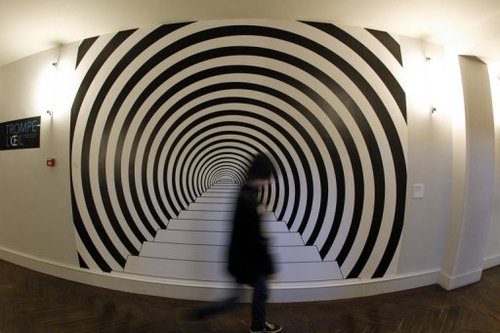AFP
5 февр. 2012 г.
'Trompe l'oeil', or the art of deception, on show in Paris
AFP
5 февр. 2012 г.
PARIS - "Trompe l'oeil" -- or art designed to trick the eye -- is the title of a new Paris exhibit exploring the history of illusion and pastiche, from ancient frescoes to fashion and the decorative arts.
 A visitor walks past "Down The Rabbit Hole" by Rasch (AFP, Francois Guillot) |
The first known use of trompe l'oeil, as legend would have it, dates back to ancient Greece, in the fifth century BC, when the artist Zeuxis painted a bunch of grapes so realistic that a bird flew down to peck at them.
"It's a game between the creator and the viewer, it's all about reality and perception," said curator Veronique Belloir, summing up the subject of the show which runs for 18 months at the Paris Museum of Decorative Arts.
A small selection of paintings opens the display of more than 400 artefacts, one of them a surrealist closet by the French artist Marcel Jean, its imaginary doors cracked open to offer a glimpse of the landscape beyond.
But the core of the exhibit is the place of illusion in the decorative arts, which took off in the late 19th century when wallpaper for instance was used to imitate everything from ceramic to lace or lacquer.
"Imitation is one of the great themes of the decorative arts," said co-curator Dominique Fourest. "Cost is part of the reason, but not the whole story. This was also a way for creators to develop their virtuosity."
Technical innovations such as linoleum were used to reproduce floorboards or mosaic, while glass imitated onyx or malachite, and ceramic posed as wood, leather or woven reeds.
Late 19th century handbooks offered craftsmen exquisitely precise guides to imitating rare materials, such as specific types of marble, or decorative styles from ancient Greece to China or the Islamic world.
"It's an endless game," said Fourest.
Reaching back in history, trick jugs from the 16th century had holes pierced in the sides, the liquid poured through concealed double walls.
A thick pile of leather-bound books, mounted on a wooden stool, prises open to reveal a chamber pot, an 18th-century marvel of invention and coyness.
Fashion has also made copious use of the trompe l'oeil genre, starting in the 1920s with Italian designer Elsa Schiaparelli, who created knitted sweaters patterned with make-believe scarves or accessories.
"Fashion is quite unashamed to talk about faux-collars, false lashes, wigs and faux-crocodile," said Belloir.
Among a dozen anthology outfits on display is a sporty, zippered man's coat by Jean Paul Gaultier printed with the pattern of a tweed jacket.
Likewise a piece carried out for Chanel's haute couture collection in 1983, by the embroidery master Francois Lesage, imitates a set of jewellery.
There is also a woman's jumpsuit, created by Sonia Rykiel in 2008, with a classic dungaree top patterned on the front.
The fashion world's love affair with trompe l'oeil is highlighted by the exhibition's cover photograph, a 1973 snap of a man seated at a Paris cafe, a jacket painted onto his naked torso.
In a quirky twist, the curators discovered the story behind the picture on the eve of the opening, from the designer himself, Ruben Torres, who told them he drew clothes onto his models' bodies after failing to complete his collection on time for a fashion show.
(www.lesartsdecoratifs.fr)
by Emma Charlton
Копирайт © 2024 AFP. Все права защищены. Любая информация даннного раздела защищена законом об интелектуальной собственности и не может быть скопирована, перепечатана, изменена, издана или использована в коммерческих целях.

























